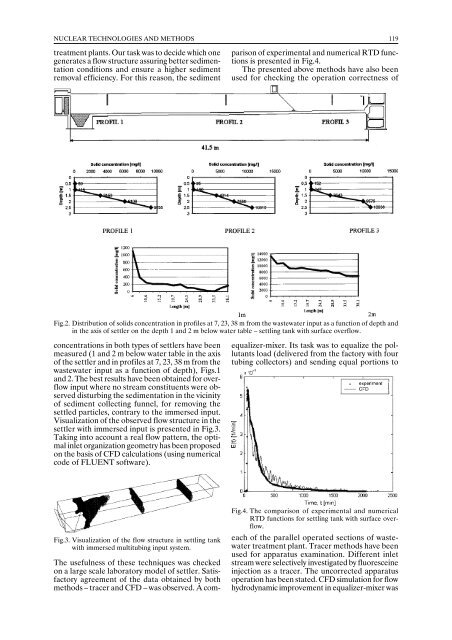annual report annual report annual report annual report 2005
annual report annual report annual report annual report 2005
annual report annual report annual report annual report 2005
Create successful ePaper yourself
Turn your PDF publications into a flip-book with our unique Google optimized e-Paper software.
NUCLEAR TECHNOLOGIES AND METHODS 119<br />
treatment plants. Our task was to decide which one<br />
generates a flow structure assuring better sedimentation<br />
conditions and ensure a higher sediment<br />
removal efficiency. For this reason, the sediment<br />
The usefulness of these techniques was checked<br />
on a large scale laboratory model of settler. Satisfactory<br />
agreement of the data obtained by both<br />
methods – tracer and CFD – was observed. A comparison<br />
of experimental and numerical RTD functions<br />
is presented in Fig.4.<br />
The presented above methods have also been<br />
used for checking the operation correctness of<br />
Fig.2. Distribution of solids concentration in profiles at 7, 23, 38 m from the wastewater input as a function of depth and<br />
in the axis of settler on the depth 1 and 2 m below water table – settling tank with surface overflow.<br />
concentrations in both types of settlers have been<br />
measured (1 and 2 m below water table in the axis<br />
of the settler and in profiles at 7, 23, 38 m from the<br />
wastewater input as a function of depth), Figs.1<br />
and 2. The best results have been obtained for overflow<br />
input where no stream constituents were observed<br />
disturbing the sedimentation in the vicinity<br />
of sediment collecting funnel, for removing the<br />
settled particles, contrary to the immersed input.<br />
Visualization of the observed flow structure in the<br />
settler with immersed input is presented in Fig.3.<br />
Taking into account a real flow pattern, the optimal<br />
inlet organization geometry has been proposed<br />
on the basis of CFD calculations (using numerical<br />
code of FLUENT software).<br />
equalizer-mixer. Its task was to equalize the pollutants<br />
load (delivered from the factory with four<br />
tubing collectors) and sending equal portions to<br />
Fig.3. Visualization of the flow structure in settling tank<br />
with immersed multitubing input system.<br />
Fig.4. The comparison of experimental and numerical<br />
RTD functions for settling tank with surface overflow.<br />
each of the parallel operated sections of wastewater<br />
treatment plant. Tracer methods have been<br />
used for apparatus examination. Different inlet<br />
stream were selectively investigated by fluoresceine<br />
injection as a tracer. The uncorrected apparatus<br />
operation has been stated. CFD simulation for flow<br />
hydrodynamic improvement in equalizer-mixer was
















